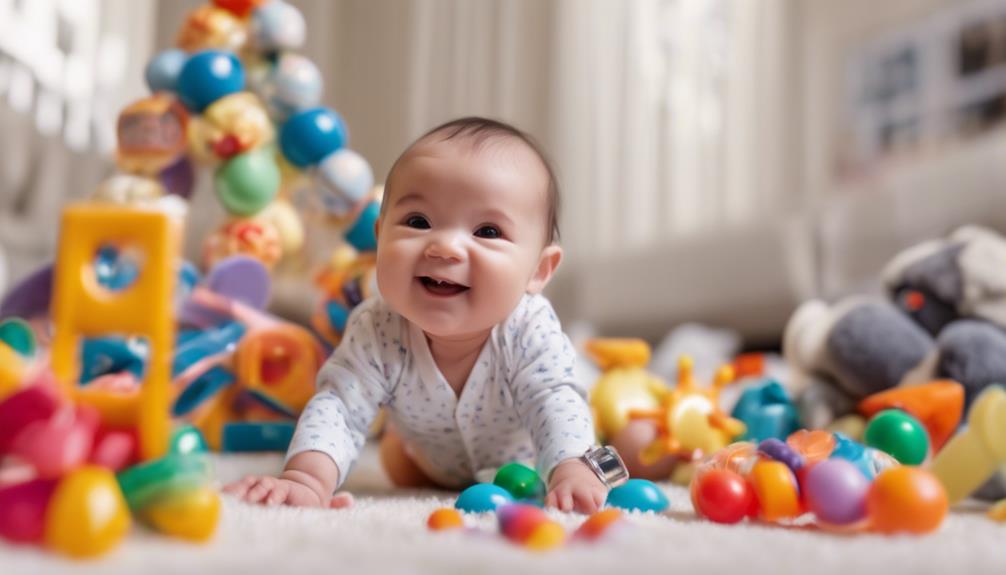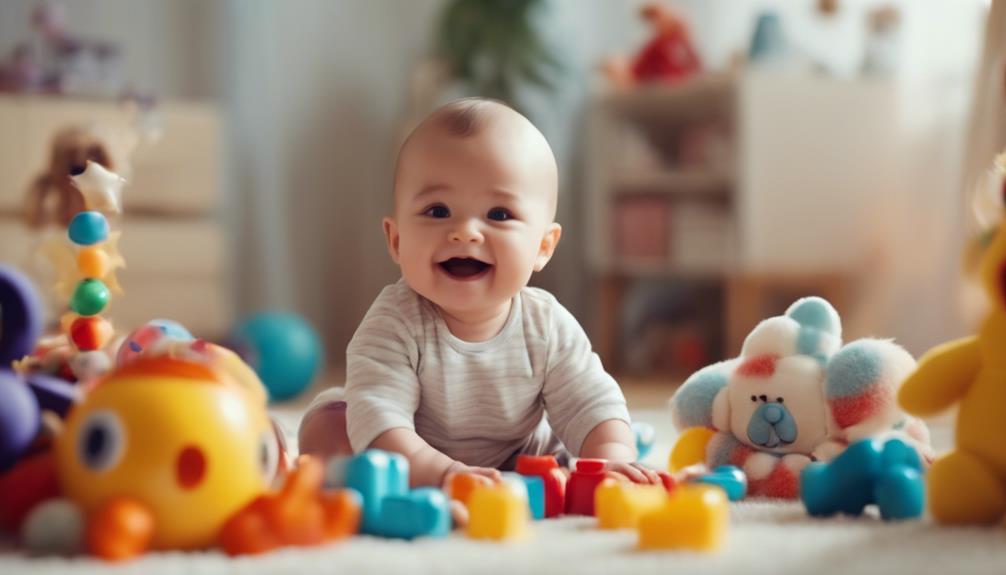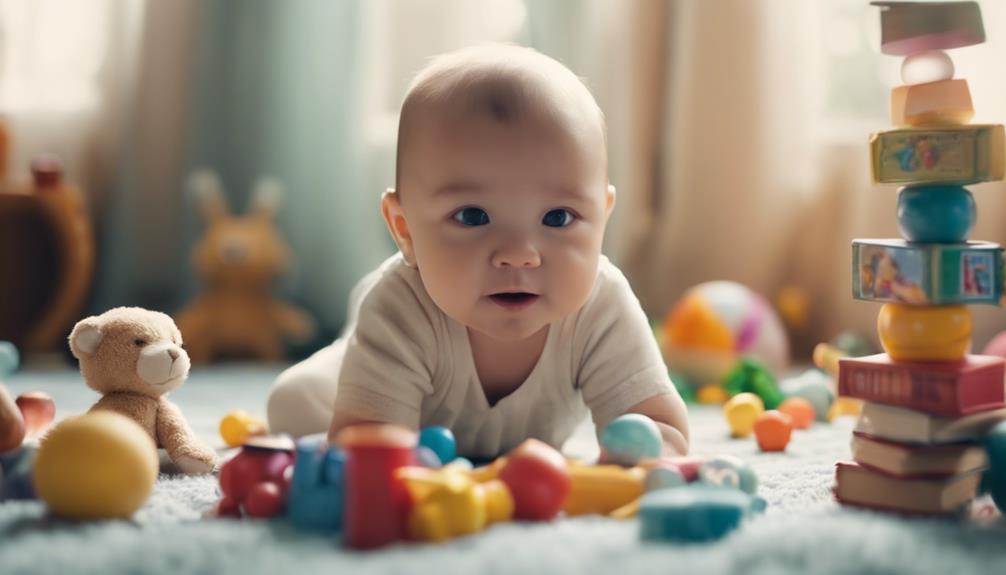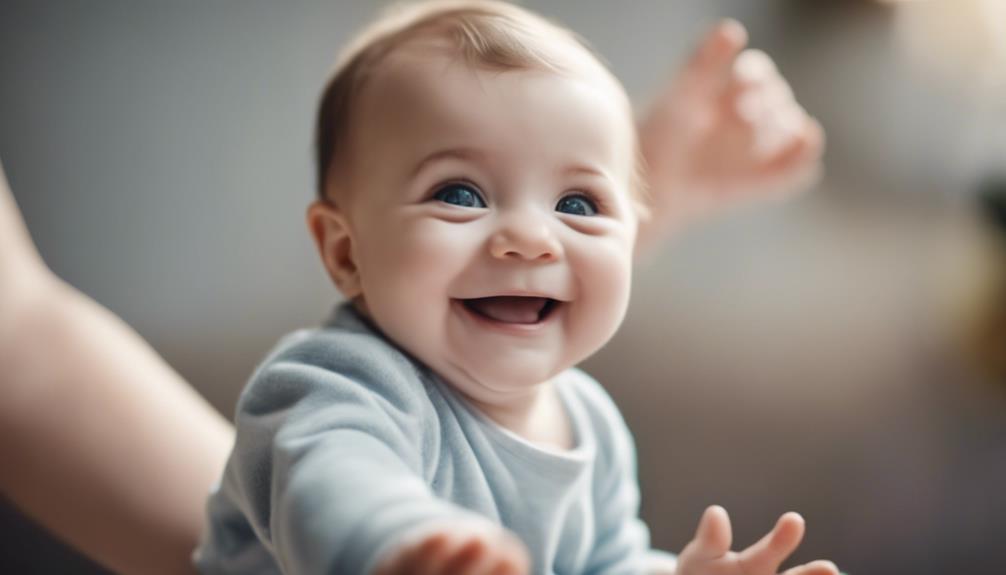At two months old, your baby is reaching various milestones. They are expressing happiness by smiling, making soft sounds, and recognizing voices. Your little one is actively interacting with their environment, attempting to grasp small objects, and exploring by reaching out towards things nearby. Socially, they are starting to recognize faces, showing authentic smiles, and forming preferences. Physically, they are steadily gaining weight, focusing on developing motor skills such as lifting their head, and strengthening neck muscles during tummy time. Keep monitoring their progress and consulting with your pediatrician to ensure they are meeting important developmental milestones. Every day brings new joys as your baby continues to thrive and develop.
Key Takeaways
- Smiling, cooing, and engaging actively with surroundings.
- Recognizing voices, reacting to stimuli, and developing emotional connections.
- Progress in motor skills, attempting to hold objects, and exploring surroundings.
- Enhanced sensory and emotional recognition, turning towards sounds, and tracking objects.
- Growing cognitive abilities, developing sensory responses, and advancing social interaction.
Developmental Milestones at 2 Months
At 2 months, your baby starts displaying significant developmental milestones, such as smiling, cooing, and actively engaging with their surroundings. This stage marks an important period in your baby's growth and cognitive abilities.
During this time, your baby will also begin experimenting with vocal sounds, attempting to hold onto small objects, and swiping at nearby items to explore. Physical development is notable, with an average weight gain of about 2 pounds per month.
It's essential to encourage tummy time for your baby's healthy development. This practice not only helps strengthen their neck and shoulder muscles but also aids in preventing flat spots on the back of their head. Ensuring your baby engages in tummy time activities can also enhance their visual focus on colors and objects in their environment.
Emotional Expressions and Reactions

By 2 months, your baby will start to show their emotions more distinctly.
You'll notice them smiling and cooing, especially in response to familiar faces.
Their ability to recognize voices and react to them will also become more apparent during this stage of development.
Smiling and Cooing
Upon reaching 2 months old, your baby begins to exhibit engaging emotional expressions through smiling and cooing. These initial signs of emotional development and communication skills are pivotal milestones in your baby's growth.
The emergence of smiling responsively shows a deeper connection with caregivers, fostering bonds and enhancing social interactions. Additionally, the introduction of cooing as your baby experiments with vocal sounds further improves their ability to communicate and engage with the world around them.
Notably, smiling at familiar faces, particularly the mother, becomes a significant aspect of your baby's emotional development. The increased interaction and responsiveness displayed through smiling and cooing signify growing emotional connections and pave the way for enhanced bonding experiences.
These early emotional expressions are foundational in shaping your baby's social development, facilitating communication skills, and establishing meaningful relationships with caregivers and loved ones.
Recognizing Familiar Faces
Recognizing familiar faces at 2 months old, your baby displays emotional expressions and reactions that signify growing connections with loved ones. As your little one catches sight of familiar faces, you may notice a spark of joy in their eyes or a delighted coo escaping their lips. This emotional connection is a beautiful milestone that reflects the bond forming between your baby and those closest to them. The first smiles directed at primary caregivers, especially the mother, are heartwarming indicators of early bonding experiences.
Furthermore, your baby's cognitive development is evident as their improved eyesight allows them to track moving objects with more precision. This ability showcases their growing awareness of the world around them.
Additionally, preferences for sweet smells and tastes, along with the recognition of familiar faces and the ability to track objects, demonstrate the budding sensory and emotional recognition that's developing within your 2-month-old.
Responding to Voices
At 2 months old, your baby begins to respond to voices by turning their head towards familiar sounds they recognize. This is a significant milestone in their social and emotional development. When spoken to by familiar voices, your baby may exhibit various emotional reactions such as smiles, coos, or even crying. Encouraging interaction through talking and singing not only stimulates their senses but also helps strengthen the bond between caregiver and baby.
To understand your baby's responses to voices better, here is a table highlighting some common behaviors you may observe:
| Baby's Response to Voices | Description |
|---|---|
| Turns head towards sound | Recognizing familiar voices |
| Calms down or becomes alert | Reacting to voices |
| Smiles or coos | Showing positive emotional reactions |
| Cries | Expressing distress or discomfort |
| Seeks comfort from familiar voices | Seeking reassurance |
Increasing Awareness of Surroundings

As your 2-month-old baby grows, you may notice heightened sensory responses to their environment. They're becoming more adept at recognizing familiar faces, bringing a smile to their little face when they see a beloved caregiver.
Curiosity sparks as new sounds capture their attention, paving the way for an exciting journey of exploration and learning.
Heightened Sensory Responses
Babies at 2 months old start demonstrating heightened sensory responses, showing a growing awareness of their surroundings. At this stage, they exhibit increased awareness of the world around them, becoming more attuned to sensory experiences.
Their visual skills improve as they begin to focus on and track moving objects with more precision. Babies may show preferences for familiar faces, sweet smells, and visually stimulating objects, indicating their developing sensory responses.
These sensory experiences, including touch, sound, and taste, play a vital role in their cognitive development. By responding to various stimuli, infants engage actively with their environment, enhancing their understanding and interaction with the world.
It's during this period that their sensory abilities are rapidly evolving, forming the foundation for future cognitive growth. Encouraging and nurturing these heightened sensory responses can further support the baby's overall development and exploration of their surroundings.
Recognition of Familiar Faces
By 2 months old, infants begin to show an increasing awareness of their surroundings through the recognition of familiar faces. At this stage, babies can differentiate between family members and strangers, displaying a preference for familiar faces.
The ability to recognize caregivers' faces plays a vital role in fostering attachment and forming emotional bonds. This recognition not only brings comfort and security but also leads to more frequent smiling and cooing interactions with loved ones. It marks the onset of social development, signifying a deeper connection with primary caregivers.
As babies start to distinguish familiar faces from unfamiliar ones, they lay the foundation for building relationships and understanding social cues. This milestone is a significant step in the infant's journey towards forming meaningful connections and mastering the social world around them.
Curiosity About New Sounds
Showing an increasing curiosity about new sounds, 2-month-old infants begin to demonstrate heightened awareness of their surroundings. They may turn their heads towards voices, react to familiar sounds, and exhibit interest in music or soothing sounds. This exploration of auditory stimuli helps babies differentiate between various sounds, laying the groundwork for future language development. At this age, babies might also start babbling or cooing in response to sounds, showcasing their early communication skills. Parents can further stimulate their infants' auditory senses by engaging them in interactive conversations, singing songs, or playing gentle music. Encouraging this curiosity about new sounds not only fosters a deeper bond between parent and child but also supports the infant's cognitive development. This phase of auditory discovery is a positive indicator of healthy growth as babies actively engage with the sounds around them, paving the way for further sensory exploration.
| Curiosity | New Sounds | Auditory Senses |
|---|---|---|
| Babbling | Cooing | Differentiation |
Social Interaction and Communication
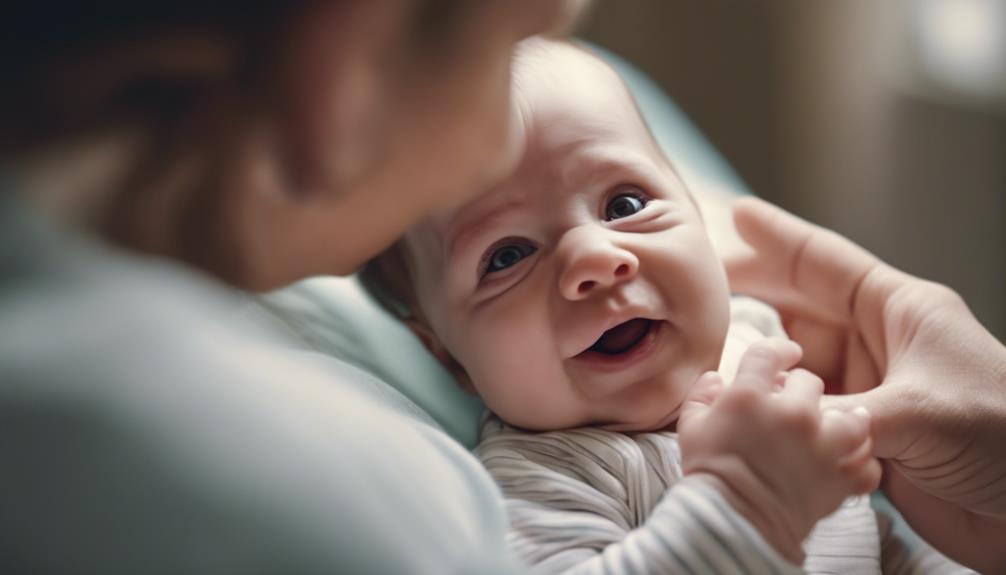
Enhancing their social interaction and communication skills, 2-month-old infants begin to recognize faces and display early signs of engagement when spoken to. At this age, babies often give their first genuine smile, usually directed towards their primary caregiver, such as the mother.
Their improved eyesight enables them to track moving objects, enhancing their visual communication abilities. Additionally, babies show preferences for sweet smells and tastes, familiar faces, and tracking objects, indicating early social and sensory development.
Notably, their focus on gross motor skills, like lifting their head during tummy time and kicking legs on their back, showcases early physical communication milestones. These interactions help lay the foundation for future social interactions and language development.
Encouraging and responding to these early signs of engagement can foster a strong bond between the baby and their caregivers, supporting the infant's overall social and emotional growth.
Physical and Cognitive Progress
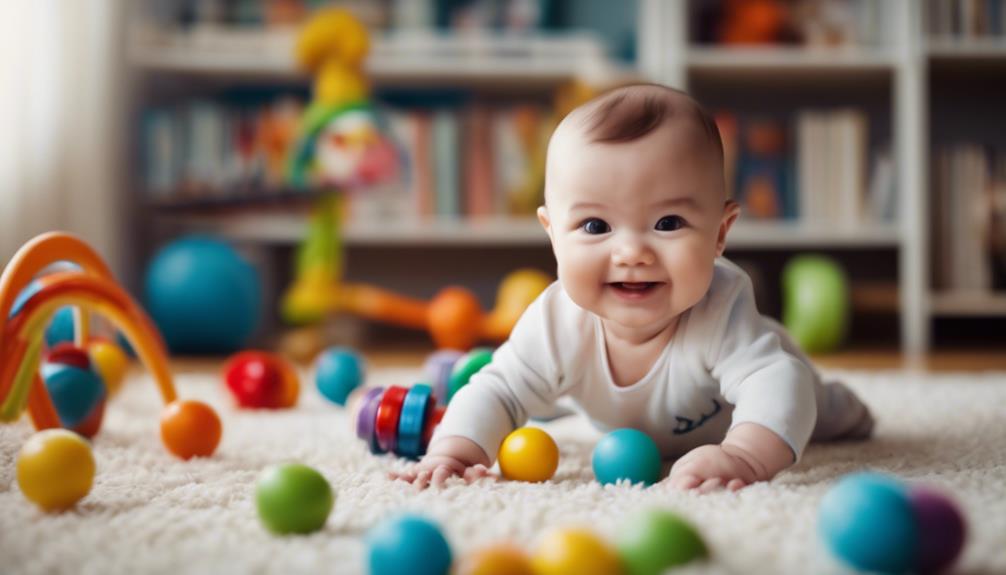
By the time your baby reaches 2 months old, you'll notice significant progress in their physical and cognitive abilities.
From steady weight gain to enhanced eyesight, your little one is growing and developing at a rapid pace.
It's a fascinating time as they start to show signs of recognizing faces and engaging with their surroundings, setting the stage for further advancements in their motor skills and cognitive functions.
Growth and Development
The physical and cognitive progress of a 2-month-old baby includes significant advancements in their sensory abilities and cognitive development. At 2 months, babies typically weigh between 5-11.5 pounds for girls and 5-12 pounds for boys, with lengths ranging from 18-22 inches for girls and 19-22.5 inches for boys. During this stage, babies strengthen their neck muscles during tummy time, improve their focus on nearby objects and people, and develop a clearer vision of colors.
In terms of sensory and cognitive development, 2-month-old babies begin to recognize caregivers' faces, actively listen and respond to voices, and understand different types of cries for hunger or sleep. They also engage in self-soothing behaviors like sucking on their hands, which promote comfort and bonding.
Additionally, babies exhibit more deliberate movements, such as attempting to hold onto small objects and swiping at things within their reach, showcasing their growing motor skills and cognitive abilities.
Motor Skills Advancement
As your 2-month-old baby grows, their motor skills are advancing rapidly, showing improvements in both physical and cognitive development. At this age, your little one is developing stronger neck muscles, allowing for better head control during tummy time.
Movements are becoming more refined, evolving from jerky to controlled motions, indicating progress in motor skill development. You may notice your baby swiping at objects and attempting to grasp small items, a sign of cognitive and physical advancements. Enhanced focus on nearby objects and people enables babies to track moving objects with their eyes, further boosting cognitive abilities.
Additionally, around 2 months old, babies begin displaying deliberate movements and self-soothing behaviors such as sucking on their hands, demonstrating cognitive and physical growth.
Cognitive Abilities Blooming
Cognitive development flourishes rapidly in 2-month-old babies, as they enthusiastically engage with the world around them through newfound recognition and responsiveness.
Here are some exciting cognitive milestones you can expect your little one to reach:
- Recognizing Faces: Your baby may start to show preference towards familiar faces, turning their head or focusing their gaze when they see someone they know.
- Responding to Sounds: 2-month-olds are becoming more attuned to voices and sounds, often turning towards where the sound is coming from or quieting down when spoken to.
- Tracking Objects: With improving eyesight, babies at this age are beginning to follow and track moving objects with their eyes, showcasing their visual development.
- Social Interaction: Early signs of social interaction are emerging as your baby smiles at you, shows interest in their surroundings, and responds positively to interactions, fostering important social skills.
These cognitive advancements not only signify your baby's growth but also lay the foundation for their future learning and communication abilities.
Feeding Milestones and Patterns

When feeding your 2-month-old baby, focus on following a responsive and flexible schedule that meets their nutritional needs. Breastfed babies typically consume 4-5 ounces every 3-4 hours, while formula-fed babies take in 4-5 ounces every 4 hours. It's important to adhere to the recommended responsive feeding method to make sure your baby's requirements are met adequately. Remember to refrain from introducing solid foods or water before 6 months; stick to breast milk or formula for proper nourishment. Feeding schedules for full-term infants without medical conditions generally involve frequent, on-demand feedings. If you have a preterm infant or specific concerns regarding your baby's feeding habits, seek advice from your pediatrician. Below is a table summarizing the feeding patterns for breast milk and formula feeding at the 2-month mark:
| Feeding Type | Amount (ounces) | Frequency |
|---|---|---|
| Breast Milk | 4-5 | Every 3-4 hours |
| Formula Feeding | 4-5 | Every 4 hours |
Sleep Patterns and Habits

Establishing healthy sleep patterns for your 2-month-old baby is crucial for their overall development and well-being. Understanding the sleep patterns of babies at this age can help you create a regular schedule that promotes longer stretches of restful sleep at night.
Here are some tips to guide you through this stage:
- Monitor Sleep Cues: Watch for signs of sleepiness such as yawning, rubbing eyes, or decreased activity to make sure your baby gets enough rest.
- Bedtime Routine: Establish a calming bedtime routine to signal to your baby that it's time to wind down and prepare for sleep.
- Nap Schedule: Aim for 3-5 naps during the day with short awake periods in between to prevent overtiredness and promote better sleep at night.
- Consistent Environment: Create a sleep-friendly environment by keeping the room dark, quiet, and at a comfortable temperature to help your baby maintain a regular sleep schedule.
Daily Routine and Activities
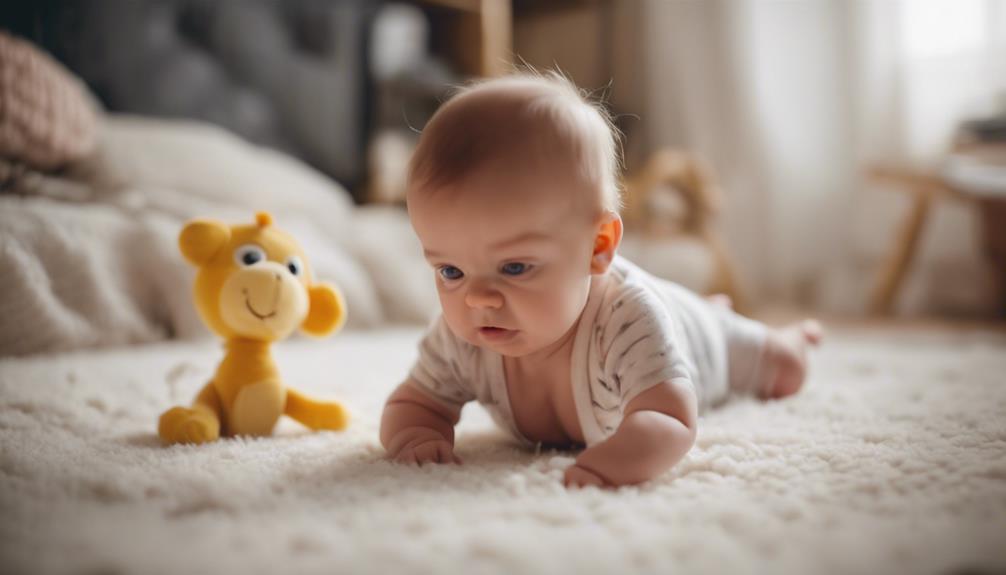
Maintaining a structured daily routine and engaging in stimulating activities are essential for fostering your 2-month-old baby's development and well-being. Consistent feeding times, naps, and play sessions create a sense of security for your little one.
Activities like tummy time, infant massage, and interactive play not only stimulate your baby's sensory and motor development but also strengthen your bond. Encourage social interaction by talking, singing, and making eye contact throughout the day. These interactions are vital for your baby's emotional growth and language development.
Incorporating short outdoor walks or gentle stroller rides can introduce your baby to new sights, sounds, and experiences, further enriching their world. Utilize colorful and textured toys, soft books, and music to engage their senses and promote cognitive development.
Health and Growth Check-In

Regularly monitoring your 2-month-old baby's health and growth is important for ensuring they're developing appropriately. Here are some key points to keep in mind during this important growth check-in:
- Weight and Height: At this age, babies typically gain 5-7 ounces per week and grow around 0.5-1 inch per month. The average weight for a 2-month-old is approximately 11.3 pounds for girls and 12.3 pounds for boys. Similarly, the average length is about 22 inches for girls and 22.5 inches for boys.
- Consulting a Pediatrician: It's crucial to track your baby's growth and seek advice from a pediatrician for any concerns or deviations from the average growth patterns. Regular visits to the pediatrician can help ensure your baby is on the right track.
- Following WHO Standards: Adhering to the World Health Organization's growth standards can help in monitoring your baby's health and development progress accurately.
- Sleep Schedule: Observing your baby's sleep patterns is important for their overall well-being. Making sure they're getting enough rest plays a significant role in their growth and development.
Care Tips and Safety Considerations

To guarantee your 2-month-old baby's well-being and safety, it's important to implement proper care tips and consider key safety measures in your daily routine.
Regular check-ups with the pediatrician are essential for vaccinations and growth monitoring.
Following safe sleep practices, such as placing your baby on their back to sleep and avoiding loose bedding, reduces the risk of Sudden Infant Death Syndrome (SIDS).
Keep a close eye on your baby's temperature regulation to prevent overheating or chilling, especially during extreme weather conditions.
Be cautious with pacifier use to prevent dependency and potential dental issues as your baby grows.
Additionally, baby-proofing your home is vital to create a safe environment for your little one to explore and develop.
Frequently Asked Questions
What Is a Quote for a 2 Month Old Baby?
You're looking for a quote for a 2-month-old baby. Here it is: "Two months old, a world of firsts, smiles, and wonders. Your presence lights up the room with love, joy, and precious moments. Enjoy this time of new discoveries!"
What Should a 2 Month Old Baby Be Doing Developmentally?
You should see your 2-month-old smiling, cooing, and getting more interactive. They're recognizing faces, following moving objects, lifting their head during tummy time, and kicking their legs. Sweet smells, familiar faces, and tracking are common preferences.
Why Is My 2 Month Old so Happy?
You may notice your 2-month-old is happy due to increased responsiveness, smiles, and interactions with familiar faces and objects. Improved visual tracking, deliberate movements, and developing sensory skills contribute to their joy and contentment.
What Do You Say to a 2 Month Old Baby?
When talking to your 2-month-old, use high-pitched tones and simple words. Engage in baby talk by repeating sounds. Encourage eye contact and respond to their coos. Your baby may show joy and responsiveness to your voice.
Conclusion
To sum up, at 2 months old, your baby is reaching important developmental milestones. They are becoming more aware of their surroundings and starting to interact socially.
It's fascinating to note that by this age, babies can already recognize familiar faces and respond to voices. Remember to continue providing a safe and nurturing environment for your little one as they grow and learn at an incredible pace.
Keep up the good work and enjoy this special time with your happy 2-month-old!

